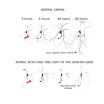(Press-News.org) October 31, 2012, Cambridge, MA, and Shenzhen, China – BGI, the world's largest genomics organizations, announced today it is among 101 research organizations comprising the 1000 Genomes Project Consortium that has successfully constructed an integrated map of genetic variation from 1,092 human genomes, providing an invaluable resource for researchers to better understand the contribution of genetics to diseases. The latest study was published as an Advance Online Publication in Nature.
As an international public-private consortium, the 1000 Genomes Project Consortium reported in 2010* that, in sequencing the whole genomes of 179 individuals, it had detected over 95% of variants at 5% frequency. However, some lower-frequency variants that are enriched for potentially functional mutations and exhibit increased levels of population differentiation remain to be characterized.
Significantly, in this latest study, the consortium provided a more comprehensive and accurate integrated haplotype map, including 38 million SNPs, 1.4 million bi-allelic indels, and 14,000 more large deletions. This data set captured up to 98% of variants at 1% frequency in populations, making available powerful approaches for researchers to conduct sequencing-based disease studies in order to benefit human health.
The study is highly innovative in its design. Using a combination of low-coverage whole-genome and exome targeted sequencing, researchers sequenced the genomes of 1,092 individuals from 14 populations drawn from Europe, East Asia, sub-Saharan Africa, and the Americas. To construct the integrated map, they also developed methodologies to combine information across multiple algorithms and diverse data resources.
As one of the participating organizations, BGI contributed sample collection, sequencing, identification of genome variations, among other activities. In sample collection, BGI was responsible for all Chinese samples, including Han Chinese in Beijing (CHB), Han Chinese South (CHS) populations. For whole genome sequencing, 8 in 14 populations and 272 individuals were sequenced on BGI's sequencing platforms. For exome targeted sequencing, 11 in 14 populations and 375 individuals were sequenced by BGI. In data analysis, BGI participated in the detection of small InDels and large deletions. Also, BGI contributed additional efforts in sequencing coordination, data quality control, among others.
Xiaosen Guo, Project Manager from BGI, said, "This work presents a higher resolution human genetic variation map, especially including the low frequency mutation sites, for researchers worldwide to better explore the relationship between phenotype and genotype in human genetic disease studies. Thus, it is a major milestone in human genome research, not only for the 1000 Genomes Project, but also for broader human disease research."
Jun Wang, Executive Director of BGI, said, "This is another major breakthrough toward the achievement of personalized human medicine using next-generation sequencing technologies. The data obtained in this study are freely and publicly accessible to research communities all over the world. They provide an invaluable resource for researchers to better conduct genome-wide association studies and other medical research studies in the future."
###
* A map of human genome variation from population scale sequencing, Nature. 2010 October 28; 467(7319): 1061.
About BGI
BGI was founded in 1999 with the mission of being a premier scientific partner to the global research community. The goal of BGI is to make leading-edge genomic science highly accessible through its investment in infrastructure that leverages the best available technology, economies of scale, and expert bioinformatics resources. BGI, which includes both private non-profit genomic research institutes and sequencing application commercial units, and its affiliates, BGI Americas, headquartered in Cambridge, MA, and BGI Europe, headquartered in Copenhagen, Denmark, have established partnerships and collaborations with leading academic and government research institutions as well as global biotechnology and pharmaceutical companies, supporting a variety of disease, agricultural, environmental, and related applications.
BGI has established a proven track record of excellence, delivering results with high efficiency and accuracy for innovative, high-profile research which has generated over 250 publications in top-tier journals such as Nature and Science. These accomplishments include sequencing one percent of the human genome for the International Human Genome Project, contributing 10 percent to the International Human HapMap Project, carrying out research to combat SARS and German deadly E. coli, playing a key role in the Sino-British Chicken Genome Project, and completing the sequence of the rice genome, the silkworm genome, the first Asian diploid genome, the potato genome, and, most recently, have sequenced the human Gut metagenome, and a significant proportion of the genomes for 1,000 genomes. For more information about BGI please visit www.genomics.cn or www.bgiamericas.com.
Media Contact:
Xiaosen Guo
Project Manager
BGI
guoxs@genomics.cn
www.genomics.cn
Bicheng Yang
Public Communication Officer
BGI
+86-755-82639701
yangbicheng@genomics.cn
www.genomics.cn
Joyce Peng, Ph.D.
Marketing Director
BGI Americas
626-222-5584
joyce.peng@bgiamericas.com
www.bgiamericas.com END
BGI contributes sequencing and bioinformatics expertise to international 1000 Genomes research
The latest study was published online in Nature
2012-11-01
ELSE PRESS RELEASES FROM THIS DATE:
High blood cholesterol is overlooked
2012-11-01
High blood cholesterol, a serious hereditary disease, is far more common than previously recognised and not treated sufficiently. This is shown in new research from the University of Copenhagen and Herlev Hospital, and the results have recently been published in the well-reputed American scientific journal, The Journal of Clinical Endocrinology & Metabolism.
A group of scientists from the University of Copenhagen has recently shown that far more Danes than expected suffer from high blood cholesterol. The study also shows that the serious hereditary disease is not treated ...
UC Santa Barbara scientists learn how to unlock the destiny of a cell: A gift for the tin man?
2012-11-01
(Santa Barbara, Calif.) –– Scientists have discovered that breaking a biological signaling system in an embryo allows them to change the destiny of a cell. The findings could lead to new ways of making replacement organs.
The discovery was made in the laboratory of Joel H. Rothman, a professor in the Department of Molecular, Cellular, and Developmental Biology at UC Santa Barbara. The studies were reported in the interdisciplinary journal Genes and Development, and were carried out by Ph.D student Nareg Djabrayan, in collaboration with Rothman and two other members of ...
How race and touchdown celebrations affect football player rewards
2012-11-01
The post-touchdown celebration is a familiar part of many football games. However, new research from the Kellogg School of Management at Northwestern University suggests that black players may be more likely than white players to be penalized for putting their feelings on display.
As a part of the study, Kellogg Ph.D. candidate Erika V. Hall and Professor Robert Livingston first analyzed all of the unsportsmanlike conduct penalties by NFL athletes during the entire 2010-2011 NFL season. Unsportsmanlike conduct includes the excessive celebration penalty. They found that ...
Cellular landscaping: Predicting how, and how fast, cells will change
2012-11-01
A research team at the National Institute of Standards and Technology (NIST) has developed a model* for making quantifiable predictions of how a group of cells will react and change in response to a given environment or stimulus—and how quickly. The NIST model, in principle, makes it possible to assign reliable numbers to the complex evolution of a population of cells, a critical capability for efficient biomanufacturing as well as for the safety of stem cell-based therapies, among other applications.
The behavior and fate of cells are only partially determined by their ...
New discovery shows promise in future speed of synthesizing high-demand nanomaterials
2012-11-01
NORMAN, Okla. – A new discovery by University of Oklahoma and North Carolina State University researchers shows a breakthrough in speeding up the process for synthesizing transition metal oxide nanostructures. What had once taken days can now be accomplished instantaneously.
After previous success using an oxygen-enriched flame to synthesize common nanomaterials, such as carbon nanotubes, nanofibers and fullerenes, OU College of Engineering professor Wilson Merchán-Merchán and his team conducted experiments using the same method to create a new form of nanostructures. ...
Study finds that adding soy to the diet does not affect onset of menopausal hot flashes
2012-11-01
(SACRAMENTO, Calif.) — A team of investigators led by UC Davis found that eating soy products such as soy milk and tofu did not prevent the onset of hot flashes and night sweats as women entered menopause.
Unlike previous studies investigating the relationship between soy and these menopausal symptoms, the current study included a very large population over a long period of time: more than 1,600 women over 10 years.
The article, titled "Phytoestrogen and Fiber Intakes in Relation to Incident Vasomotor Symptoms: Results from the Study of Women's Health Across the Nation," ...
Gene required for nerve regeneration identified
2012-11-01
A gene that is associated with regeneration of injured nerve cells has been identified by scientists at Penn State University and Duke University. The team, led by Melissa Rolls, an assistant professor of biochemistry and molecular biology at Penn State, has found that a mutation in a single gene can entirely shut down the process by which axons -- the parts of the nerve cell that are responsible for sending signals to other cells -- regrow themselves after being cut or damaged. "We are hopeful that this discovery will open the door to new research related to spinal-cord ...
A glimpse into neurosurgical risk prevention and the surgical checklist
2012-11-01
Charlottesville, VA (November 1, 2012). The November issue of Neurosurgical Focus is dedicated to lessening the number and severity of adverse events surrounding neurosurgical intervention for a variety of disorders. Guest editors Alexander Khalessi (University of California, San Diego), James Forrest Calland (University of Virginia), Gabriel Zada (University of Southern California), and Michael Y. Wang (University of Miami Health System) selected 16 articles on systems-based quality improvement for neurosurgical procedures.
The articles are divided into four major subtopics: ...
An elephant that speaks Korean
2012-11-01
An Asian elephant named Koshik can imitate human speech, speaking words in Korean that can be readily understood by those who know the language. The elephant accomplishes this in a most unusual way: he vocalizes with his trunk in his mouth.
The elephant's vocabulary consists of exactly five words, researchers report on November 1 in Current Biology, a Cell Press publication. Those include "annyong" ("hello"), "anja" ("sit down"), "aniya" ("no"), "nuo" ("lie down"), and "choah" ("good"). Ultimately, Koshik's language skills may provide important insights into the biology ...
JCI early table of contents for Nov. 1, 2012
2012-11-01
Congenital diarrheal disorder linked to a mutation in DGAT1
Congenital diarrheal disorders (CDD) are a group of rare intestinal diseases that are caused by genetic mutations. In a study published in the Journal of Clinical Investigation, Robert Farese and colleagues at the University of California, San Francisco, identified a family with two of three children affected by CDD. The affected children both carried a rare mutation in the DGAT1 gene. DGAT1 mediates the formation of triglycerides and is being assessed as a therapeutic target in the treatment of obesity. The study ...
LAST 30 PRESS RELEASES:
AI-based tool predicts future cardiovascular events in patients with angina
Researchers map how the cerebellum builds its connections with the rest of the brain during early development
Routine scans could detect early prostate radiotherapy changes
Fairness in AI: Study shows central role of human decision-making
Pandemic ‘beneath the surface’ has been quietly wiping out sea urchins around the world
Tea linked to stronger bones in older women, while coffee may pose risks
School feeding programs lead to modest but meaningful results
Researchers develop AI Tool to identify undiagnosed Alzheimer's cases while reducing disparities
Seaweed based carbon catalyst offers metal free solution for removing antibiotics from water
Simple organic additive supercharges UV treatment of “forever chemical” PFOA
£13m NHS bill for ‘mismanagement’ of menstrual bleeds
The Lancet Psychiatry: Slow tapering plus therapy most effective strategy for stopping antidepressants, finds major meta-analysis
Body image issues in adolescence linked to depression in adulthood
Child sexual exploitation and abuse online surges amid rapid tech change; new tool for preventing abuse unveiled for path forward
Dragon-slaying saints performed green-fingered medieval miracles, new study reveals
New research identifies shared genetic factors between addiction and educational attainment
Epilepsy can lead to earlier deaths in people with intellectual disabilities, study shows
Global study suggests the underlying problems of ECT patients are often ignored
Mapping ‘dark’ regions of the genome illuminates how cells respond to their environment
ECOG-ACRIN and Caris Life Sciences unveil first findings from a multi-year collaboration to advance AI-powered multimodal tools for breast cancer recurrence risk stratification
Satellite data helps UNM researchers map massive rupture of 2025 Myanmar earthquake
Twisting Spins: Florida State University researchers explore chemical boundaries to create new magnetic material
Mayo Clinic researchers find new hope for toughest myeloma through off-the-shelf immunotherapy
Cell-free DNA Could Detect Adverse Events from Immunotherapy
American College of Cardiology announces Fuster Prevention Forum
AAN issues new guideline for the management of functional seizures
Could GLP-1 drugs affect risk of epilepsy for people with diabetes?
New circoviruses discovered in pilot whales and orcas from the North Atlantic
Study finds increase in risk of binge drinking among 12th graders who use 2 or more cannabis products
New paper-based technology could transform cancer drug testing
[Press-News.org] BGI contributes sequencing and bioinformatics expertise to international 1000 Genomes researchThe latest study was published online in Nature


